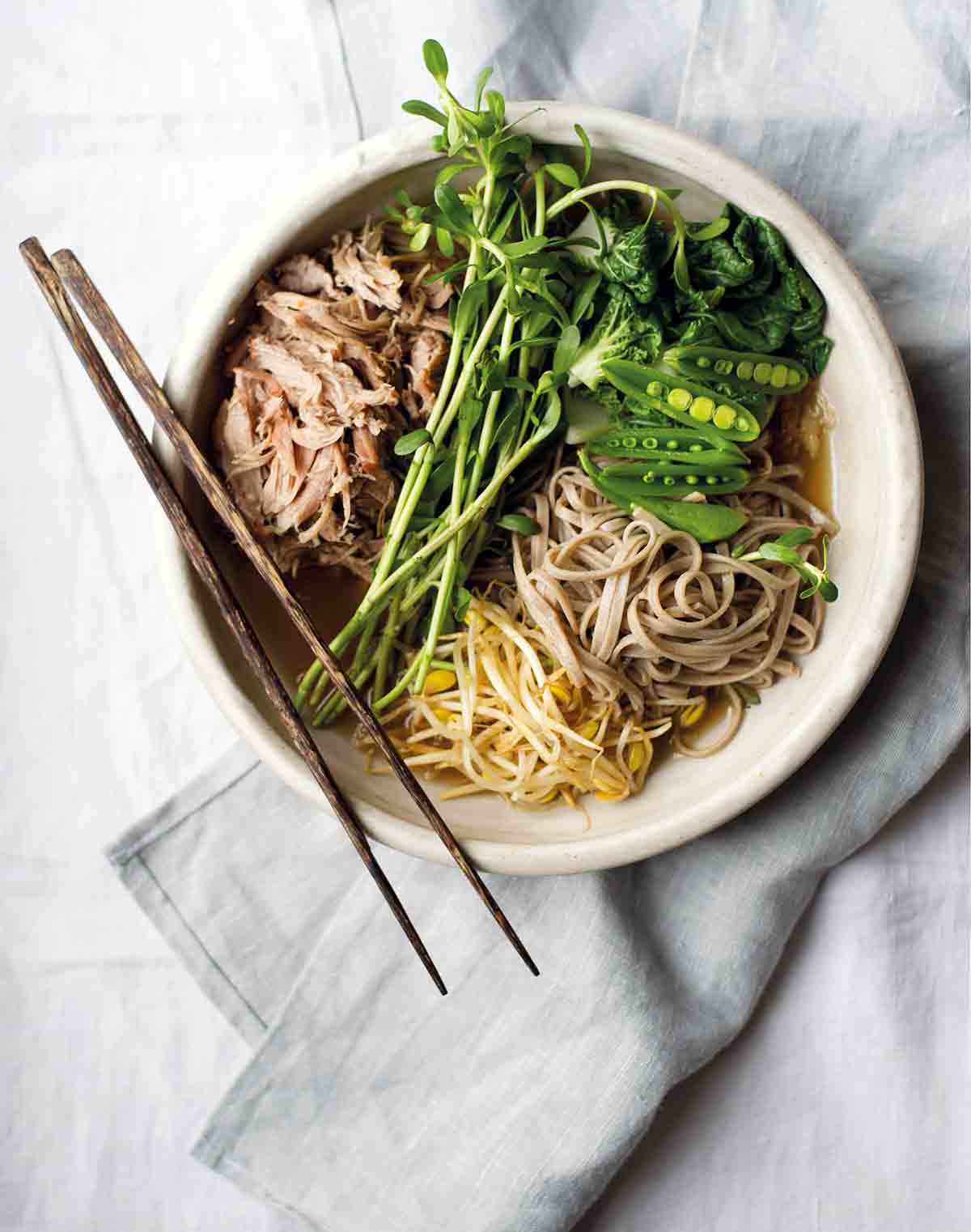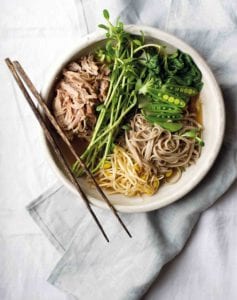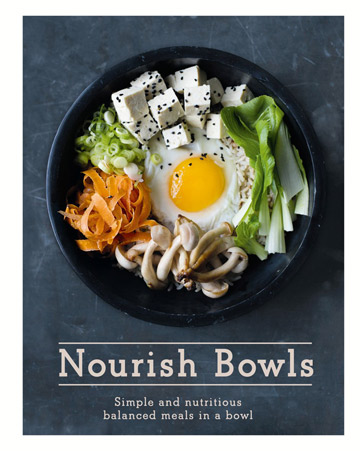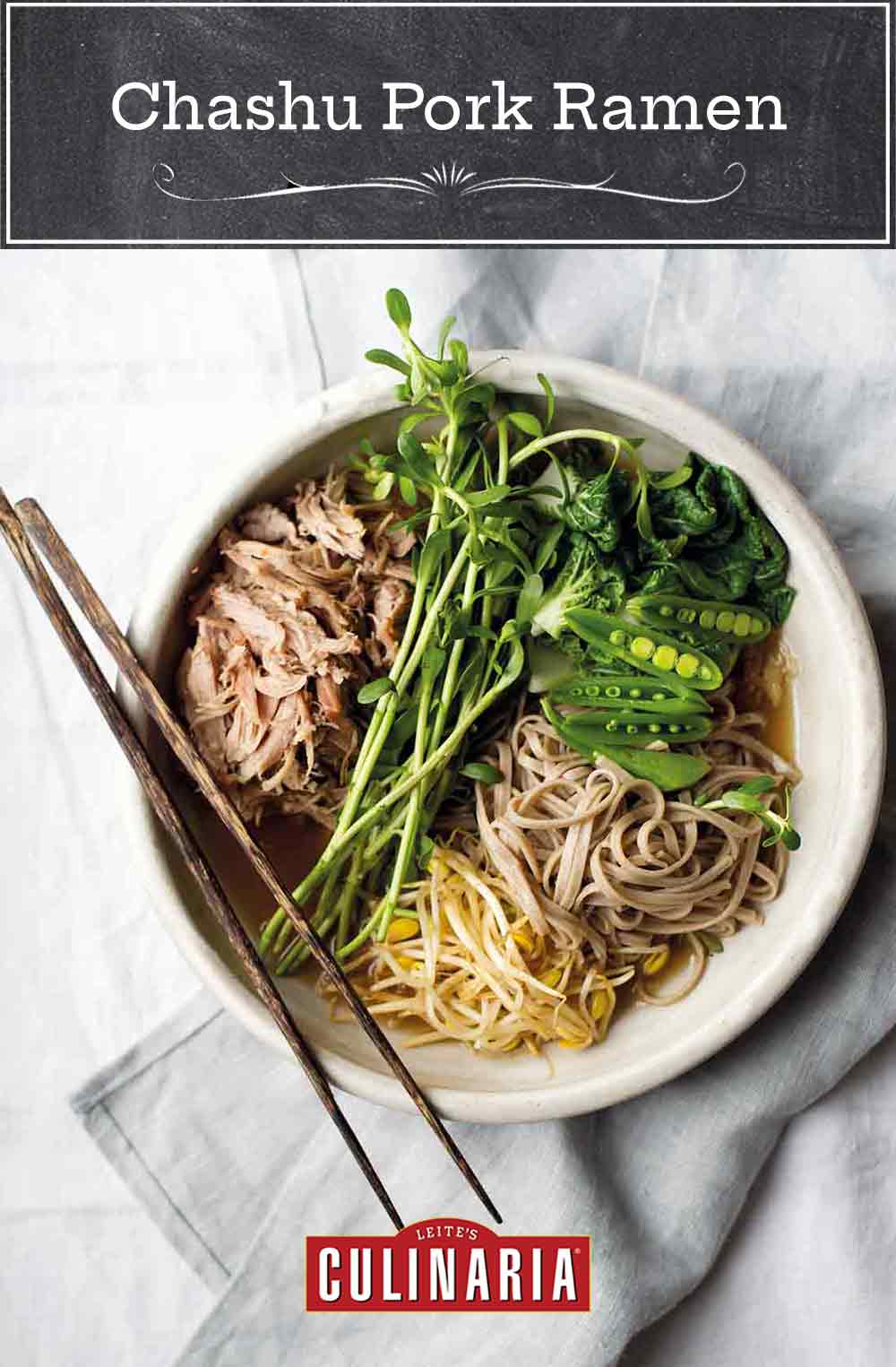
This outstanding marriage of chashu pork ramen melds soba noodles and crisp vegetables is soul-satisfying in that way only slowly cooked, fall-apart-tender pork can be. The ingredients for the traditional Japanese braise, namely soy sauce, sake, mirin, and rice wine, then double as a broth for the finished dish.–Angie Zoobkoff
Want to Save This?

Chashu Pork Ramen
Ingredients
For the chashu pork
- 1 3/4 pounds bone-in pork shoulder
- 1/2 cup light soy sauce
- 1 cup sake (or substitute rice wine)
- 1 cup mirin
- 1 cup rice wine
- 3 1/2 tablespoons coconut sugar or 3 tablespoons granulated sugar
- 1 thumb-size piece ginger, sliced
- 6 to 7 about 7 oz shallots, peeled
For the noodles and vegetables
- 9 ounces soba noodles
- 2 cups sugar snap peas
- 8 ounces baby bok choy
For the bowl
- Handful bean sprouts
- Handful pea shoots or purslane
Instructions
Make the chashu pork
- Preheat the oven to 300°F (150°C).
- In a Dutch oven or flame-proof baking dish over medium-high heat, combine the pork, soy sauce, sake, mirin, rice wine, coconut sugar, ginger, and shallots. Bring to a boil, cover, and transfer to the oven.
- Cook until the pork is incredibly tender and shreds very easily, 4 to 4 1/2 hours.
- Remove from the oven, uncover, and let the pork rest in the liquid until cool enough to handle.
Make the noodles and vegetables
- Bring a large saucepan of salted water to a boil over high heat. Cook the soba noodles according to the instructions on the package.
- While the noodles are cooking, fill a large bowl halfway with ice water. Using tongs, transfer the cooked noodles to the water. Keep the water boiling.
- Prepare another large bowl filled halfway with ice water. Blanch the sugar snap peas and baby bok choy in the boiling water for 1 minute.
- Using tongs or a slotted spoon, immediately plunge the vegetables into the ice water to stop the cooking process. Drain and pat dry.
Assemble the bowl
- Remove the pork from the braising liquid and use 2 forks to shred the pork. Skim any fat from the surface of the braising liquid (or let the liquid cool, cover, and refrigerate it for up to a couple days and skim the fat before reheating).
- Add about 1/2 cup shredded pork to each serving bowl and divvy the noodles, sugar snap peas, and baby bok choy among the bowls. Add a handful of bean sprouts and some pea shoots or purslane to each and then ladle some of the braising liquid from the pork dish into each bowl.

Explore More with AI
Nutrition
Nutrition information is automatically calculated, so should only be used as an approximation.
Recipe Testers’ Reviews
This chashu pork ramen recipe is way better than take out.
Prepping the meat for the braise was very simple, hardly any hands on time there. I trimmed a lot of the excess fat from the meat and assembling the rest of the ingredients for the braising liquid was very quick. I was able to find coconut sugar so I used that.
I would suggest that during the long braise time you spend some time prepping the vegetables. Once the blanching and assembling of the bowls takes place it all moves very quickly. I sliced the baby bok choy into halves and left the sugar snap peas as they were. The pork, while braising, smelled great.
As I’d trimmed a lot of the fat off before cooking , there was little fat to skim off the broth. We got about 6 servings. The pea shoots were a little ungainly to eat whole so I’d probably cut them smaller next time.
The blanching of the vegetables took almost no time at all and the soba noodles took 6 minutes as per the package instructions. They were flexible but not too soft. And after layering the noodles, veggies and pork we ladled over about a cup of the broth. All in all, it made for a very enjoyable meal we all thought was better than takeout.
You could prepare the meat on a weekend when you have extra time and refrigerate it for a weeknight where all you’d have to do is reheat the meat and broth while you blanch the vegetables and cook the noodles.
I would think this could also be made in a slow cooker to make dinner preparations easier.












Chashu, as an ingredient in Japanese Ramen (chashumen) is made with rolled pork belly or sometimes pork belly in block form.
Pork shoulders or butts aren’t common in Japan.
Bkhuna, you’re right, pork belly is the traditional choice for chashu, but Japanese home cooks who prefer leaner cuts choose pork butt or leg/ham. Some even completely free themselves from the convention and use chicken instead. The key is the salty/sweet flavor profile achieved by marrying soy sauce with sugar, mirin, honey, etc. Another common thread is the cooking method, which is “low and slow.”